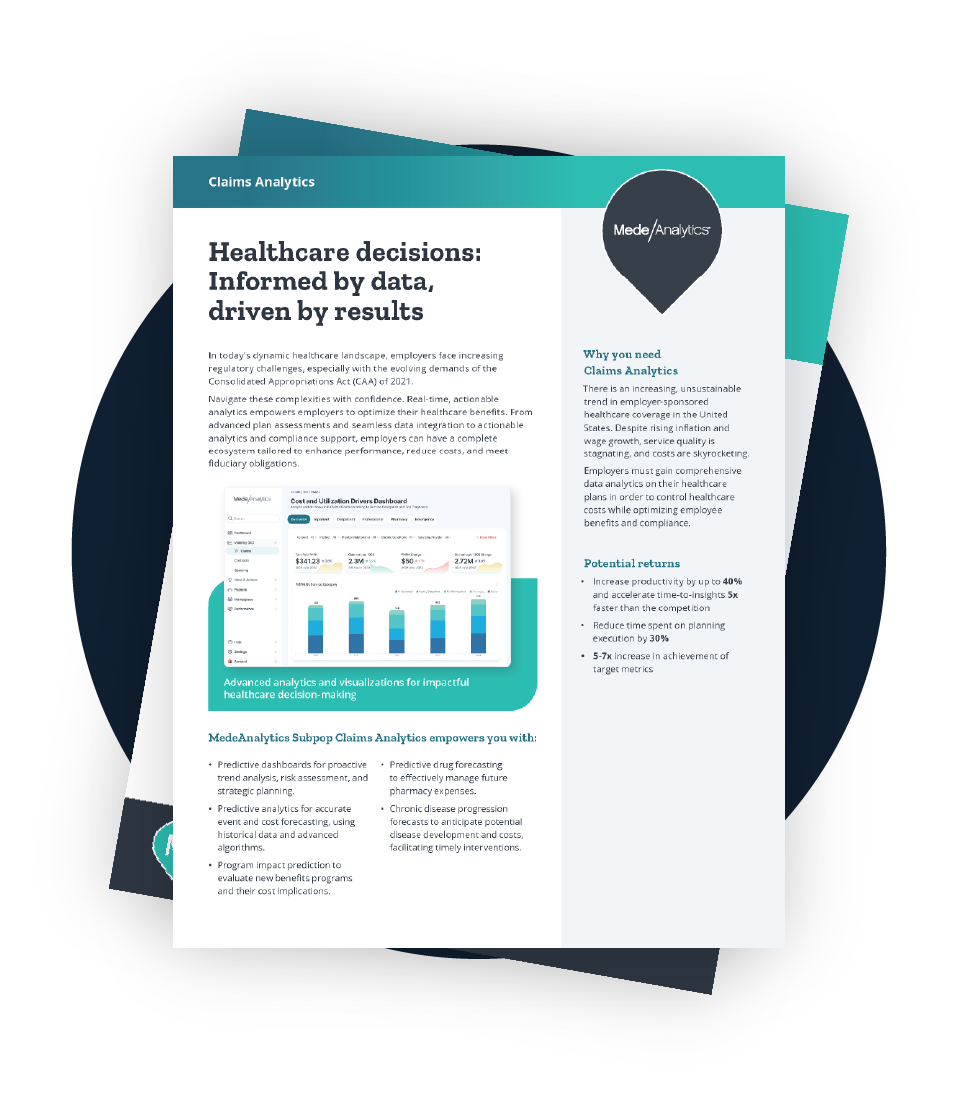Blueprint:
Employers can slash healthcare costs and improve care quality by using data transparency tools and strategic procurement. This approach empowers employers to understand current and future healthcare expenses, leading to better employee outcomes and stronger financial performance.
In this comprehensive guide, we'll explore the current employer healthcare ecosystem, identify barriers to improvement, and highlight key areas where employers can make a significant improvement on healthcare costs.
The ecosystem
The employer-sponsored healthcare ecosystem is an intricate network of stakeholders, each playing a crucial role in the delivery and financing of healthcare services. Understanding this ecosystem is essential for developing effective cost management strategies.
Key stakeholders
- Employers
- Employees and their dependents
- Advisors, consultants, and Brokers
- Healthcare providers
- Insurance companies
- Pharmacy Benefit Managers (PBMs)
- Government regulators
These stakeholders interact in complex ways, often with competing interests that can drive up costs. For instance, while employers aim to reduce healthcare expenses, providers and insurers may have incentives to increase utilization and prices.
All of this combined, employer-sponsored healthcare is undergoing significant change, marked by rising costs and decreasing access. With healthcare spending continuing to climb, there’s a growing burden on businesses that offer coverage to their employees. These escalating costs often result in higher premiums with increasing out-of-pocket expenses for employees, including deductibles, co-pays and coinsurance.
While employers struggle to manage rising costs, employees are facing affordability challenges and navigating a Byzantine healthcare landscape. Access to quality care is increasingly difficult due to healthcare worker shortages, particularly in rural and underserved areas. This provider scarcity is compounded by rising pharmaceuticals and medical service prices, making it harder for individuals to afford necessary treatments.
In addition, hospital system and insurance payer consolidation is limiting choices for both employers and employees, potentially leading to higher prices and reduced competition. Factor in the administrative complexities of managing employer-sponsored health plans and the burden continues to grow. Employers are grappling with the difficulty of offering competitive benefits packages while mitigating the ever-increasing cost of providing healthcare coverage.
How can we harness this dynamic to create a more sustainable and innovative future for employer-sponsored healthcare?
Understanding improvement barriers
Several barriers hinder efforts to improve cost management in employer-sponsored healthcare. Recognizing these challenges is the first step toward developing effective solutions.
Healthcare costs continue to outpace inflation and wage growth. This puts a significant strain on employer budgets, making it increasingly difficult to offer comprehensive benefits with acceptable deductibles while remaining competitive and profitable.
One of the most significant barriers to cost management is the lack of transparency in healthcare pricing and quality metrics. Without clear information, employers and employees struggle to make informed decisions about care options and costs.
Managing employer-sponsored health plans is complex. Employers must navigate a maze of regulations, choose from a wide array of plan options, and manage relationships with multiple vendors, such as insurance companies, pharmacy benefit managers, and wellness program providers, many of which have incentives that are not aligned with employers.
Employers have a legal and ethical obligation to act in the best interests of their plan participants (employees) when making decisions about their healthcare plans. Failure to meet fiduciary obligations can expose employers to legal liability and costly litigation.
While advancements in healthcare technology offer promising solutions, many organizations face challenges in implementing and integrating these technologies effectively. They need a strong partner well-versed in healthcare to ensure success in implementing the right technology solutions that can unify and leverage disparate data silos and optimize existing infrastructure.
Areas for impact
Despite these challenges, employers have several opportunities to impact healthcare costs positively.
By leveraging data-driven strategies, organizations can make informed decisions and implement targeted interventions.
Utilizing advanced analytics can help employers identify high-risk individuals and implement targeted interventions. This proactive approach can lead to significant cost savings and improved health outcomes. According to a study published in the Journal of Healthcare Management and Economics, predictive analytics can reduce healthcare costs by up to 15% when implemented effectively.
The adoption of telemedicine and virtual care solutions can reduce costs associated with in-person visits while improving access to care. Employers should consider expanding their telemedicine offerings and educating employees on the benefits of these services.
Transitioning to value-based care models can align incentives across the healthcare ecosystem, promoting quality care and cost efficiency. Employers can work with providers and insurers to implement these models, which have shown promising results in reducing costs and improving outcomes.
With prescription drug costs continuing to rise, optimizing pharmacy benefit management is crucial. Employers can negotiate better contracts, implement step therapy programs, and encourage the use of generic alternatives to manage costs effectively.
Implementing a centralized platform designed for healthcare can significantly enhance administrative efficiency and cost management. By consolidating various administrative tasks, employers can streamline operations, improve data management, and reduce administrative costs. Centralized platforms offer scalability, enhanced compliance, and real-time data utilization, contributing to overall operational efficiency and cost reduction.
Follow the same process you use for critical service purchases: analyze provider contracts, itemize all fees, evaluate market options, negotiate competitively, implement clear service level agreements, and monitor provider performance against contract terms.
Implementing cost management strategies: Where to start
Successfully implementing these strategies requires a systematic approach. Employers should consider the following steps:
Analyze
Conduct a thorough analysis of current healthcare costs, utilization patterns and contract commitments.
Set goals
Set clear goals and metrics for cost reduction and quality improvement after understanding what is possible in the market.
Engage
Engage stakeholders, including employees, providers, and advisors in the planning process while aligning incentives.
Test
Implement pilot programs to test new strategies before full-scale adoption.
Monitor and evaluate
Continuously monitor and evaluate the effectiveness of implemented strategies against contracted commitments and clinical results.
Explore additional resources
Act now: Addressing the Employer-sponsored healthcare crisis
Employer-sponsored healthcare is at a crossroads. Costs have soared 43% in the last decade, yet quality of care is declining. This eBook explores the current state of employer-sponsored health insurance and provides a roadmap for controlling costs and improving employee health outcomes.
Healthcare decisions: Informed by data, driven by results.
Healthcare regulations are constantly shifting, and the Consolidated Appropriations Act (CAA) of 2021 has raised the stakes. Gain the confidence and control you need with real-time, actionable analytics that optimize your healthcare benefits, reduce costs and ensure compliance.
Conclusion
As we look ahead to what to do now, employer-sponsored healthcare will continue to face challenges in cost management. However, by adopting data-driven strategies and leveraging advanced technologies, employers can navigate these challenges effectively.
The key to success lies in a comprehensive approach that addresses the complexities of the healthcare ecosystem, overcomes barriers to improvement, and focuses on high-impact areas for cost reduction. By implementing the strategies outlined in this guide, employers can work toward creating a more sustainable and effective healthcare system for their employees.
Explore more on this topic from our experts:
5 powerful data analytics strategies to optimize employee health and benefits
Controlling employee healthcare costs while maintaining a healthy and productive workforce is a top priority for today’s employers. Traditional approaches…
Read on...Helping Accountable Care Organizations Navigate the Perfect Storm
In the ever-evolving landscape of healthcare, Accountable Care Organizations (ACOs) find themselves at the epicenter of a transformative era. Recently,…
Read on...Navigating the Medicare Landscape: Implications of the Latest Rule Changes for Healthcare Organizations
The Centers for Medicare & Medicaid Services (CMS) has recently unveiled significant proposed changes to Medicare Advantage (MA), Medicare Prescription…
Read on...Introduction to social risk: What healthcare leaders need to understand
‘Social determinants of health’ has been a common phrase for decades now, but the term social risk is much less…
Read on...




